
Forestry is the science and craft of creating, managing, planting, using, conserving and repairing forests, woodlands, and associated resources for human and environmental benefits. Forestry is practiced in plantations and natural stands. The science of forestry has elements that belong to the biological, physical, social, political and managerial sciences. Forest management play essential role of creation and modification of habitats and affect ecosystem services provisioning.

Coppicing is a traditional method of woodland management which exploits the capacity of many species of trees to put out new shoots from their stump or roots if cut down. In a coppiced wood, which is called a copse, young tree stems are repeatedly cut down to near ground level, resulting in a stool. New growth emerges, and after a number of years, the coppiced tree is harvested, and the cycle begins anew. Pollarding is a similar process carried out at a higher level on the tree in order to prevent grazing animals from eating new shoots. Daisugi, is a similar Japanese technique.
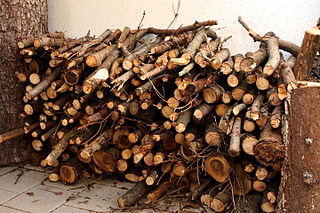
Firewood is any wooden material that is gathered and used for fuel. Generally, firewood is not highly processed and is in some sort of recognizable log or branch form, compared to other forms of wood fuel like pellets or chips. Firewood can be seasoned and heat treated (dry) or unseasoned (fresh/wet). It is generally classified as hardwood or softwood.
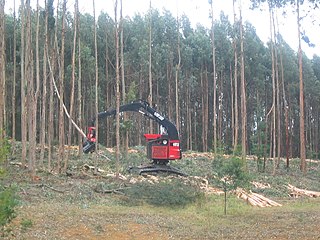
Pulpwood is timber with the principal use of making wood pulp for paper production.

Wood fuel is a fuel such as firewood, charcoal, chips, sheets, pellets, and sawdust. The particular form used depends upon factors such as source, quantity, quality and application. In many areas, wood is the most easily available form of fuel, requiring no tools in the case of picking up dead wood, or few tools, although as in any industry, specialized tools, such as skidders and hydraulic wood splitters, have been developed to mechanize production. Sawmill waste and construction industry by-products also include various forms of lumber tailings.

In the United Kingdom, an ancient woodland is a woodland that has existed continuously since 1600 or before in England, Wales and Northern Ireland. Planting of woodland was uncommon before those dates, so a wood present in 1600 is likely to have developed naturally.
This article is the index of forestry topics.
Wildcrafting is the practice of harvesting plants from their natural, or 'wild' habitat, primarily for food or medicinal purposes. It applies to uncultivated plants wherever they may be found, and is not necessarily limited to wilderness areas. Ethical considerations are often involved, such as protecting endangered species, potential for depletion of commonly held resources, and in the context of private property, preventing theft of valuable plants, for example, ginseng.
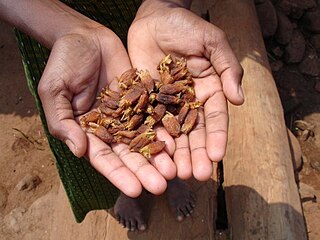
Non-timber forest products (NTFPs) are useful foods, substances, materials and/or commodities obtained from forests other than timber. Harvest ranges from wild collection to farming. They typically include game animals, fur-bearers, nuts, seeds, berries, mushrooms, oils, sap, foliage, pollarding, medicinal plants, peat, mast, fuelwood, fish, insects, spices, and forage. Overlapping concepts include non-wood forest products (NWFPs), wild forest products, minor forest produce, special, minor, alternative and secondary forest products – for further distinctions see the definition section below

Biomass is plant-based material used as fuel to produce heat or electricity. Examples are wood and wood residues, energy crops, agricultural residues, and waste from industry, farms and households. Since biomass can be used as a fuel directly, some people use the words biomass and biofuel interchangeably. Others subsume one term under the other. Government authorities in the US and the EU define biofuel as a liquid or gaseous fuel, used for transportation. The European Union's Joint Research Centre use the concept solid biofuel and define it as raw or processed organic matter of biological origin used for energy, for instance firewood, wood chips and wood pellets.
The following outline is provided as an overview of and guide to forestry:

Biomass heating systems generate heat from biomass.
The systems fall under the categories of:

The American Tree Farm System (ATFS) is the largest and oldest woodland certification system in America. It is internationally recognized by the Programme for the Endorsement of Forest Certification and meets strict third-party certification standards. It is one of three certification systems currently recognized in the United States. ATFS specializes in certifying private forests, primarily those held by individuals and families and currently certifies over 24 million acres (110,000 km²) of forestland. The ATFS Standard for Certification is owned by the American Forest Foundation, a national nonprofit organization focused on promoting sustainable stewardship of America's woodlands and related environmental education through Project Learning Tree.

A forest product is any material derived from forestry for direct consumption or commercial use, such as lumber, paper, or fodder for livestock. Wood, by far the dominant product of forests, is used for many purposes, such as wood fuel or the finished structural materials used for the construction of buildings, or as a raw material, in the form of wood pulp, that is used in the production of paper. All other non-wood products derived from forest resources, comprising a broad variety of other forest products, are collectively described as non-timber forest products (NTFP). Non-timber forest products are viewed to have fewer negative effects on forest ecosystem when providing income sources for local community.
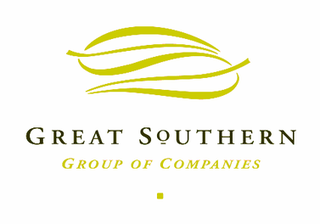
Great Southern Group was a group of Australian companies that was notable as the country's largest agribusiness managed investment scheme (MIS) business.

Forests cover about 50% of the territory of Estonia, or around 2 million hectares, and so make out an important and dominating landscape type in the country. National law and policies recognize that forests are a natural and ecological resource, and the importance of forests is to be considered from an economic, social, ecological and cultural aspect.
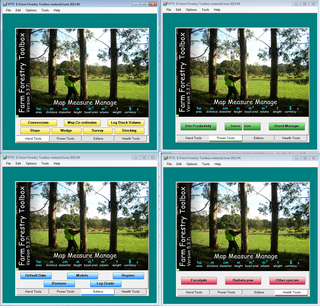
The Farm Forestry Toolbox is a collection of computer programs, referred to as 'Tools', intended to be used by farm forest owners and managers to aid decision making. The Toolbox includes a set of simple 'Hand Tools'; conversion of measurements and map co-ordinates; measuring the volume of stacked logs, slope, basal area; and a survey tool. A second set of more complex tools or 'Power Tools'; can be used to estimate site productivity, volume and value of wood grown for individual trees, at the coupe or stand level and forest estate level.

The Pioneer Mothers Memorial Forest is an 88-acre oak-hickory forest located in Orange County, Indiana, near Paoli. Identified as a surviving fragment of virgin Central Hardwood forest, a woodland type that largely vanished in the 1800s, it is a National Natural Landmark within the Hoosier National Forest.
The wood industry or timber industry is the industry concerned with forestry, logging, timber trade, and the production of primary forest products and wood products and secondary products like wood pulp for the pulp and paper industry. Some of the largest producers are also among the biggest owners of timberland. The wood industry has historically been and continues to be an important sector in many economies.
The Ontario Woodlot Association is a non-profit organization based in Kemptville, Ontario to support woodlot owners with sustainable woodlot management practices. The OWA and its chapters also engage in provincial and municipal governance, both through advocacy on behalf of their membership and contributions to government publications.















